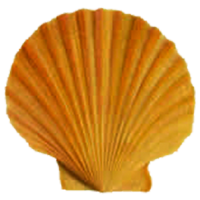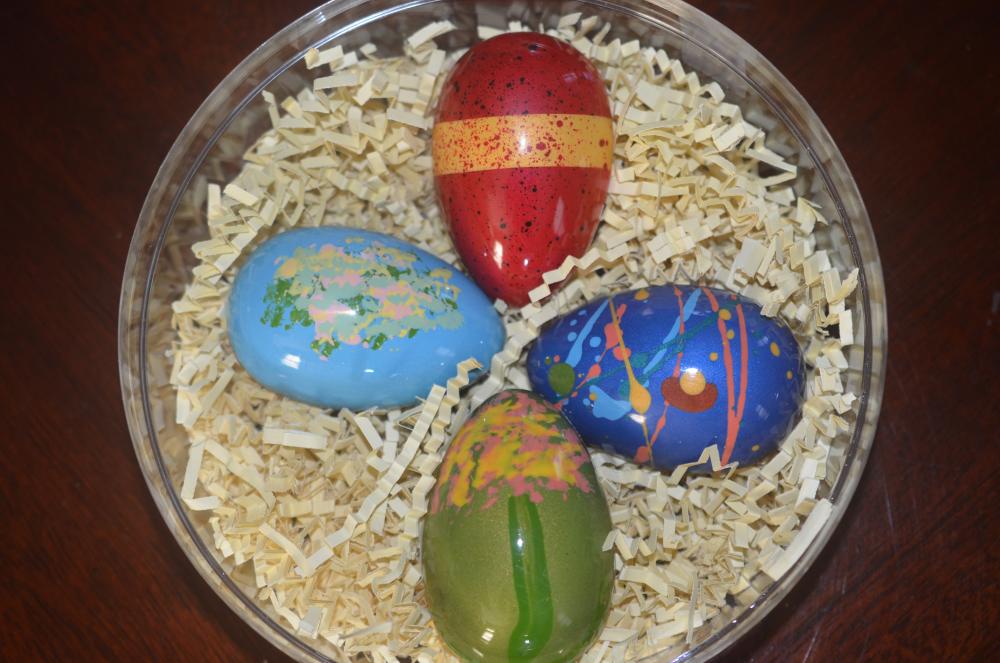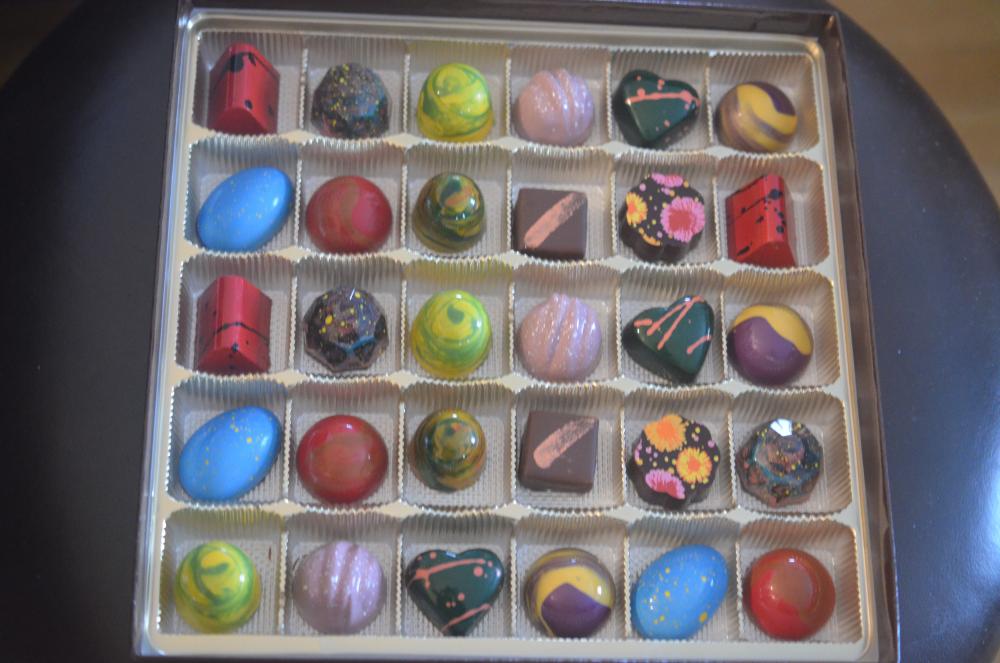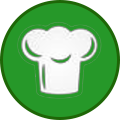-
Posts
2,411 -
Joined
-
Last visited
Content Type
Profiles
Forums
Store
Help Articles
Everything posted by Jim D.
-
Some people do it that way, but most (as far as I have seen) spread some chocolate on top of the mold, apply a transfer sheet (with a design pre-printed on it) or plain guitar sheet, then spread the chocolate with a scraper. After the chocolate has crystallized, the acetate sheet can be removed easily. Unless one is an expert, this makes a mess, with chocolate flowing down the sides of the mold. And it is also difficult to remove the chocolate between the cavities with the scraper, but not doing so means they can be very difficult to get out of the mold. Perhaps you can detect that I speak from some unhappy experience. When it works, however, this technique produces an attractive bonbon, and a transfer sheet adds a nice design touch to the bottom of the bonbon--something I have learned, to my surprise, that customers notice and really like.
-
Those are really beautiful. If you don't mind telling, how do you get such subtlety when painting with cocoa butter? Mine is almost always too fluid to stay in place and runs all over the mold. And, in the case of the bonbon on the far right, the blue color had to be painted first to get the gradient effect.
-
Can you describe what the ganache looked like? And what were the approximate temperatures of the cream and chocolate when you first tried to emulsify them?
-

Beginner considering selling candy: looking for answers to a few questions
Jim D. replied to a topic in Pastry & Baking
Like pastrygirl, I take shelf life very seriously. But I got even more serious about it when I discovered mold inside a bonbon not long ago. I went into a panic, notified people who had bought the chocolate in question, had to take the boxes off the shelves of a retail outlet. They had been stored in an air-conditioned room with temp around 65F. Turns out that's not low enough. Now I am careful to freeze anything that's going to sit around, and during the period when customers are stopping by to pick up chocolates, I keep them in the storage room, but now with the temp set at 60F. For retail outlets, I now give them instructions on how to keep some of the stock frozen and gradually bring it to fridge temp for sales. I wish I had a cooler with humidity control just for chocolates--that would make me feel better. A wine fridge has the right temp range, but you would need one large enough to hold more than you now make because if your chocolates become popular, your sales will increase more than you probably imagine at this point. No matter how much you tell customers about shelf life, there are always going to be some who stretch the consumption into a far longer time span. So even though I have an Aw meter and test every recipe, a decent reading doesn't guarantee long shelf life. In warmer weather and for freezing, I use an impulse sealer to seal all boxes of chocolates in plastic bags, which protects them from humidity. -
My Easter 2021 offerings: Eggs: (clockwise from top): strawberry cream with strawberry pâte de fruit, dark caramel with sea salt, coffee ganache & rum buttercream, crispy hazelnut gianduja. Bonbon assortment: "bananas Foster," "caramel macchiato," cherry with kirschwasser, coconut macadamia, pecan praline gianduja with toasted marshmallow, almond praline gianduja with salted caramel & shortbread, orange blossom mousse, cookie butter, hazelnut crunch with chocolate shortbread, lemon cheesecake, and dark caramel with sea salt.
-

Beginner considering selling candy: looking for answers to a few questions
Jim D. replied to a topic in Pastry & Baking
I'll respond to more of your questions when I have a little more time, but you might want to check out the hemisphere/demisphere molds I have for sale in the Classifieds section of the forum. I was not satisfied with the size of the existing ones (too small to provide a real taste of the filling) or too large (would not fit in the trays I use for boxing). My listing provides the dimensions and shows some of the bonbons I have made with them. I agree with pastrygirl that any shallow mold (eggs, hemispheres, the so-called quenelles) have the issue she mentions. BUT bonbons made with them almost always pop out of the molds without banging on the counter and they are very easy to decorate (a simple swirl of colored cocoa butter, then spray or paint with another color, or just splatter some cocoa butter of various colors across the mold). I'll add here that I have been tempted to sell at the local farmers' market and have almost given in multiple times (vendors even offered a free tent and setup), but the weather is just too problematic. And the market continued during this past December, but at that point I was up to my eyeballs making Christmas chocolates. -

Spraying Chocolate: Equipment, Materials, and Techniques
Jim D. replied to a topic in Pastry & Baking
So what else have you got to do now that the EZ is done? I always thought you were someone who enjoyed a challenge. The "EZspray" airbrush. -

Spraying Chocolate: Equipment, Materials, and Techniques
Jim D. replied to a topic in Pastry & Baking
I keep my airbrush warm in a dehydrator, and that helps a lot, but the brush does cool off. Yes, that is the Krea product to which I referred. I looked into it, but it would take so much cocoa butter that it would be completely impractical. But they are on the right track. -

Spraying Chocolate: Equipment, Materials, and Techniques
Jim D. replied to a topic in Pastry & Baking
I use the same equipment and have almost exactly the same experience. I am not sure how the compressed air (which is probably at room temperature) could be a significant factor in cooling the cocoa butter in the cup, but the metal cup certainly is. I am afraid that this is one of those "that's the way things are" situations. The cocoa butter is much warmer than the surrounding air and will cool as time passes. If my room temp is somewhat warmer, then I can do 2-4 molds without stopping, but usually I play it safe and run the heat gun briefly around the cup and the airbrush after each mold. This does not take a lot of time once you get the routine down. Switching to a plastic cup would probably help hold the temperature of the cocoa butter, but I asked Grex about how heat-resistant that cup is, and they recommended against using a heat gun with it. I have also mentioned to Grex that it would be great to have a larger metal cup, with the thought that a larger mass of cocoa butter would take longer to cool off. The person at Grex was polite but noncommittal about developing such a product. I think Grex is not fully aware of how widespread the use of their airbrushes is in the chocolatier community. My dream is that Grex (or someone) will develop an airbrush with something surrounding the cup to keep it warm, something like the Krea hotCHOC. Perhaps this could be the next project of the developer of the EZtemper! -
Yes, that's it. And I also got mine from Nashville Wraps. I still had some from a previous order, so was able to compare the two, and there was/is definitely a chemical odor in the newer one. It also looked different, so for this particular color (which was out of stock for quite a while) they must have a different source.
-
An odd topic to be sure, but at least it's seasonal: I reordered straw/grass/crinkle-cut paper for Easter baskets from my same supplier last year, and, unlike the previous supply, this batch has a off-smell, something chemical. The supplier said no one else had reported the issue, but I know it's there. What can I do to minimize the odor? Last year I had some powdered vanilla and mixed that with the straw; it helped a little, but vanilla is a rather expensive way to reach the goal. I thought of putting the batch outdoors in the sun for a while, but can't find a container large enough. Yesterday I removed all the remaining straw from the individual bags and left it where it could air out somewhat, but I need an idea that will work more quickly.
-
I ended up using Brimar Packaging in Ohio and am satisfied with them. There is a thread on packaging that is very useful.
-
It is available from my website: https://www.santiagochocolates.com/ganache.html
-
Me too. Often it seems impossible how much they crystallize overnight. Sometimes I am looking for a softer texture, but that is difficult (nearly impossible) to predict. I can attest to the deliciousness of pastrygirl's peanut butter gianduja. I think she has mail order possibilities. 😉
-
In my experience selecting the ratio of chocolate and nut paste is tricky and varies depending on the consistency of the paste. I buy hazelnut praline paste from Cacao Barry (50% nuts, 50% sugar) and mix it with chocolate (dark or milk) with twice as much paste as chocolate. This is what Peter Greweling recommends. With almond praline paste (which I make myself), however, I find that I have to use 400g chocolate and 500g paste--more chocolate because the almond paste is much more fluid. To be honest, I must say that I no longer worry too much about tempering the gianduja. For one thing, it's impossible to test it for temper. I get the mixture below 93F, then add cocoa butter silk and stir. When it begins to thicken a bit, I use it. When ordinarily I would be piping the gianduja into molds, I instead use a confectionery funnel--which has turned out to be one of the best chocolate-related purchases I have ever made. I can fill the cavities without spilling a drop. But it's crucial not to wait too long for the gianduja to get too viscous. When I want to see in advance how the gianduja will turn out, I do what Chocolot suggested: stir it over cold water (even ice water) and let it get really thick, then put a little in the refrigerator and see how it is going to turn out. Then, of course, I have to reheat it gently to get it back to pouring/piping condition. This next point is probably an obvious one, but I'll include it anyway: I find gianduja an incredibly "forgiving" product. You can reheat it innumerable times, test it (as described above), then add more chocolate or more paste to get the consistency you wish. Another note: it gets considerably more solid as it sits and I usually wait a day before doing anything more with the molds. If you are using a guitar to cut a gianduja slab, it's very tricky to get just the right moment to cut it (bitter experience speaking here). I'm not sure why your gianduja was too fluid. Did you make your own hazelnut praline paste or purchase it? In any case, I would simply add more chocolate to the gianduja and see if it improves. I can almost guarantee that by adding chocolate or paste you will eventually get the consistency you want, but this may require testing. Another option which I have used is to add some coconut oil to the gianduja. But since this keeps its consistency softer, this is obviously not your issue with this particular batch.
-

Molded and Filled Chocolates: Troubleshooting and Techniques
Jim D. replied to a topic in Pastry & Baking
As a huge fan of irony, I love this. On a (slightly) more serious note, I have found that "firm" toothbrushes work better. Ever since dentists started recommending soft toothbrushes, the firm ones are more difficult to find. And regarding Colgate: Not long ago I got a batch that shed its bristles. Not something desirable in a chocolate. Doesn't Colgate know its target audience better than that? -

Molded and Filled Chocolates: Troubleshooting and Techniques
Jim D. replied to a topic in Pastry & Baking
Thanks for the information. I'll have to take a look at the distance factor. It also seems that the viscosity of the cocoa butter (which varies from moment to moment) and the amount of cocoa butter on the toothbrush play a role. -

Molded and Filled Chocolates: Troubleshooting and Techniques
Jim D. replied to a topic in Pastry & Baking
Your splatter is very nicely done, more even than most people (including me) get from a toothbrush or a spray gun. What did you use? -
I have used peppermint, bitter almond, lemon, lime, and orange. They are especially helpful when you want to add flavor to something without significant water (such as meltaways, gianduja, chocolate).
-
I have seen many comments that the temp control on the Mol d'Art is not very accurate. For my purposes that would not be a huge factor, but it's a disappointing flaw in a device that so many people swear by. There is also the issue that, for what it does, the Mol d'Art is expensive. Thanks for the suggestion of the Control Freak. I like the idea that it would have so many other uses. I would, of course, have to get a large enough container for dumping, and it's always going to be difficult to dump something rectangular into a round bowl. Another issue I would need to look into is how tall the combination of induction cooktop plus container would be; the Mol d'Art has the advantage that it is not as tall. Thanks, that's exactly what I needed to know. Have you found the inexact temperature control extremely problematic? What about emptying the Mol d'Art container? Does it have an edge that allows for pouring without making a mess?
-
No, I'm not looking for the same temp. In fact, when I add untempered chocolate to cope with overtempering, I want to be sure it is NOT in temper and have discovered that the tempered chocolate in the Delta is quite forgiving about the temperature of the added chocolate. In other words, I can add chocolate to the Delta that is as high as 100F/37C without causing the choc to go out of temper.
-
My question about the Mol d'Art is not on message, but this seems a logical place to post it: I use a Chocovision Delta to temper and hold chocolate to make shells. The problem with dumping them is that the bowl of the Delta is round and its diameter is not quite large enough. The mess is almost more than even I can endure. I have tried various methods of dealing with the issue, with no success. What strikes me as workable would be to have a Mol d'Art melter beside the Delta, dump molds into the Mol d'Art, keep the chocolate at the right temperature, then, when the chocolate left in the Delta is getting low, ladle the melted chocolate back into it. I generally follow a similar method to deal with overtempering--have some untempered chocolate ready to add to the Delta. One question comes to mind about the Mol d'Art, and I haven't been able to locate the information: How much chocolate is required to have it work correctly? I don't know where the thermometer that regulates the thermostat is located, so don't know whether I could turn it on, then begin dumping the molds into it immediately or would have to wait for a certain quantity of chocolate to accumulate.
-
I too hate tempering Opalys. In making shells, at first it is too fluid and the shells turn out too thin unless one takes precautions. Then, at some unpredictable point, it gets quite viscous, and shells are too thick. Sometimes I have heated it to the 90F/32C point to get it to work. Once before, when I was complaining about Opalys, @Kerry Bealhappened to be going to the Valrhona factory and asked them about it. Her report: "they said the white was very susceptible to over-crystallization so you had to take care not to scrape the last bits off the table into the bowl - keep the sides of the bowl warm and scrupulously clean."
-
Opalys is my regular white chocolate. I'll look for macadamia honey. Good ideas.







